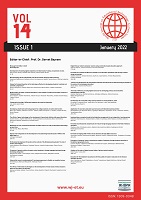Readiness for inter-professional education at health sciences: A study of educational technology perspectives
Readiness for inter-professional education at health sciences: A study of educational technology perspectives
Author(s): Marzo Roy Rillera, Soe Soe AyeSubject(s): School education, Higher Education , Health and medicine and law, ICT Information and Communications Technologies, Distance learning / e-learning, Pedagogy
Published by: Birlesik Dunya Yenilik Arastirma ve Yayincilik Merkezi
Keywords: four dimensional curriculum; inter-professional education; inter-professional learning; medical education;
Summary/Abstract: Background: Inter-professional Education (IPE), is the engagement of two or more healthcare professions in an integrated learning environment to foster collaboration and improve healthcare services. In IPE, initiatives are taken where technology is a crucial part of the learning process. Current technology practices in IPE comprise eLearning modules on collaborative practice skills and many others. This study aims to determine the readiness for inter-professional education of the health sciences students. Methods: A questionnaire called Readiness for Inter-professional Learning Scale (RIPLS) was used to assess attitudes related to inter-professional collaboration & education. Descriptive and non-parametric statistics were used to analyze the results in aggregate, as well as by each faculty. Results: Medical students gave a higher rating in terms of the perceived benefits of working together to solve patient problems compared to other faculties. Also, they were more open to working in small-group projects with other healthcare students and value the importance of shared learning to clarify the nature of patients’ problems. But compared to others, the Nursing students were unsure of what their professional role will be and wanted to acquire more knowledge and skills than other healthcare students. The total RIPLS score amongstall was in the high range. Conclusion: Thus, students were deemed ready for IPE. Recommendations: The University need to consider how to implement IPE within their curricula, define learning outcomes and/ or competencies, develop and utilize the 4Dimensional curriculum development framework in line with the health professional accreditation standards in order to promote collaboration and competence amongst all students ,whereby upon graduation, they as healthcare professionals, in turn will optimize health services, strengthen health system and improve health outcomes.
Journal: World Journal on Educational Technology: Current Issues
- Issue Year: 14/2022
- Issue No: 1
- Page Range: 93-102
- Page Count: 10
- Language: English

